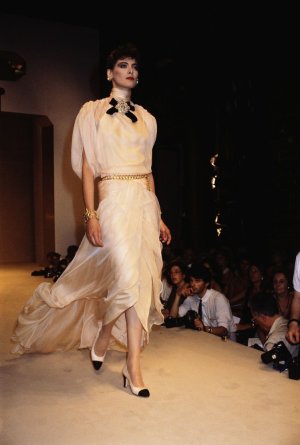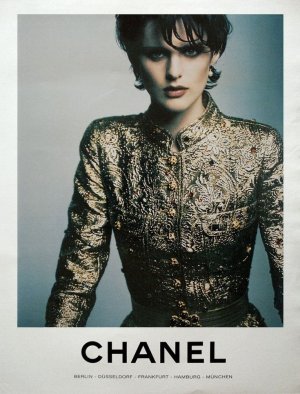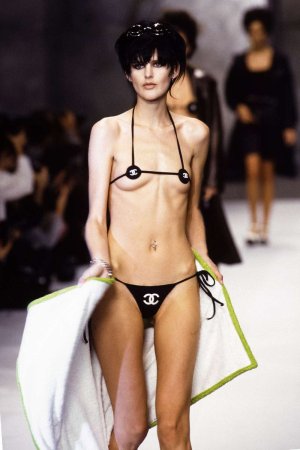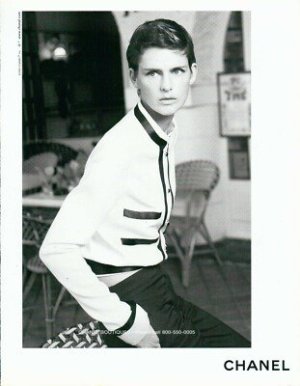You are using an out of date browser. It may not display this or other websites correctly.
You should upgrade or use an alternative browser.
You should upgrade or use an alternative browser.
Matthieu Blazy - Designer, Creative Director of Chanel
- Thread starter charles01
- Start date
Nimsay
Well-Known Member
- Joined
- Apr 13, 2023
- Messages
- 1,745
- Reaction score
- 3,144
Yes, it’s a very fashion-forward proposition - and no, it’s not masculine-presenting at all. That’s exactly my point. Its not mens clothes translated to womens clothes.
The new generation of women can wear fragile Chanel suits covered in puffy flowers and still be taken completely seriously. We’ve moved past power dressing. We’re beyond the idea that equality means wearing a man’s suit. Now it’s knit suits with plaid sequin fringe in the boardroom - and why not? What’s new about power dressing in 2025?
This is what I mean by postmodern.
Blazy is clearly influenced by Galliano, many of these silhouettes trace back to the draping techniques John pioneered. The treatment of the waist and hips especially - the way the blousing is done across the lower bust and lower thighs - it’s very Galliano 1920s filtered through Chanel. I completely see why they chose him and Im excited to see more dramatic flapper inspired draping.
This feels right for Chanel because it retains their fashion credentials plus moves the dressing conversation back to the Chanel suit leading style.
The new generation of women can wear fragile Chanel suits covered in puffy flowers and still be taken completely seriously. We’ve moved past power dressing. We’re beyond the idea that equality means wearing a man’s suit. Now it’s knit suits with plaid sequin fringe in the boardroom - and why not? What’s new about power dressing in 2025?
This is what I mean by postmodern.
Blazy is clearly influenced by Galliano, many of these silhouettes trace back to the draping techniques John pioneered. The treatment of the waist and hips especially - the way the blousing is done across the lower bust and lower thighs - it’s very Galliano 1920s filtered through Chanel. I completely see why they chose him and Im excited to see more dramatic flapper inspired draping.
This feels right for Chanel because it retains their fashion credentials plus moves the dressing conversation back to the Chanel suit leading style.
Last edited:
Omfg it is tragic.Undeniably, there is an overlap between MB’s debut Chanel show and the aesthetic of his few years at BV. But, I do see influence & likeness from Chanel shows before him too, including things that may seem “not Chanel.” Spring 2004 and 2015 seem like major influences. Not trying to prove anything with this, just sharing what I’ve been looking at. If anyone has thoughts, I’d love to hear!
Blazy hats // Spring 2015 Couture
View attachment 1425501
Fall 2016 RTW // Blazy look #28
View attachment 1425498
Fall 2010 Couture // Blazy look #52
View attachment 1425499
Spring+Fall 2021 Couture // Blazy look #20
View attachment 1425500
Spring 2004 Couture // Blazy look #56
View attachment 1425503
Spring 2004 Couture // Blazy look #71
View attachment 1425504
Spring 2004 Couture // Blazy’s look #33
View attachment 1425505
Spring 2011 & Spring 2015 Couture //
Awar’s Finale look
View attachment 1425502
I think that it is an important proposal by Blazy vs. reality.The new generation of women can wear fragile Chanel suits covered in puffy flowers and still be taken completely seriously. We’ve moved past power dressing. We’re beyond the idea that equality means wearing a man’s suit. Now it’s knit suits with plaid sequin fringe in the boardroom - and why not? What’s new about power dressing in 2025?
Chanel is all about a woman's suit - a fitted, feminine cardigan or jacket that is either fitted on the waist, the shoulders, or the sleeves (not all, but one or two) to flatter women's curves. They are never men's suits, which was Coco's original intention.
Blazy's proposals are sloppy, esp. in a business setting.
If you are dressed in a sloppy way, no one will trust your work or business instincts. In fact, some looks are totally insulting. Why is showing my underwear with my skirt even considered? Can I not make it on my own with my brain only? What message am I sending to my colleagues?
I can totally see someone in the creative field dressed like this because it is a proposal that challenges the status quo, but in the business world, you don't want people to see your clothes. You just want to give them the impression that you are smart, thoughtful, and strong. The clothes need to disappear. If you go in an office in Blazy's suits, the guys will wink at each other and talk over the stalls about how ridiculous that underwear-peeking -above-the-skirt is all about. How you wear pompons around your ears. How massive you shirt is. How your skirt is practically falling off from your hips. How your shoulders are bigger than Elene Benes' 90s jackets.
Compare this to the Coco/Karl jackets.
No men talks about them, because they just look nice.
But women will ask you in the powder room where you get your jacket from, you look great, I love the tweed, it fits you so well, and even can you introduce your sales to me?
Like I said before, unless men stop wearing well tailored suits, women will never look like this in the boardroom. I will be interested to see when Leena Nair starts wearing these when she meets the owners and even further, the bankers and the lawyers.
PDFSD
Well-Known Member
- Joined
- Mar 27, 2024
- Messages
- 2,821
- Reaction score
- 10,017
i agree i am sure they looks at chanel ism and Bottega-fied (modified) them.Undeniably, there is an overlap between MB’s debut Chanel show and the aesthetic of his few years at BV. But, I do see influence & likeness from Chanel shows before him too, including things that may seem “not Chanel.” Spring 2004 and 2015 seem like major influences. Not trying to prove anything with this, just sharing what I’ve been looking at. If anyone has thoughts, I’d love to hear!
Blazy hats // Spring 2015 Couture
View attachment 1425501
Fall 2016 RTW // Blazy look #28
View attachment 1425498
Fall 2010 Couture // Blazy look #52
View attachment 1425499
Spring+Fall 2021 Couture // Blazy look #20
View attachment 1425500
Spring 2004 Couture // Blazy look #56
View attachment 1425503
Spring 2004 Couture // Blazy look #71
View attachment 1425504
Spring 2004 Couture // Blazy’s look #33
View attachment 1425505
Spring 2011 & Spring 2015 Couture //
Awar’s Finale look
View attachment 1425502
wich in theory is fine if BV is who he is , but again the whole big CEO message was some on that respect or comes to do chanel not repeat what they do at another house.
so my irk is its not enough hardcore chanel what you expect in RTW
BALANCE OF THE EGO should be :
Hard core COCO CHANEL 2/4 - BLAZY SANS BV 1/4 - BLAZY KL CHANEL 1/4
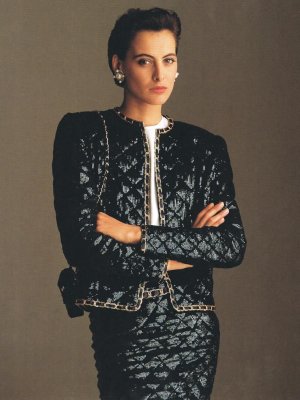
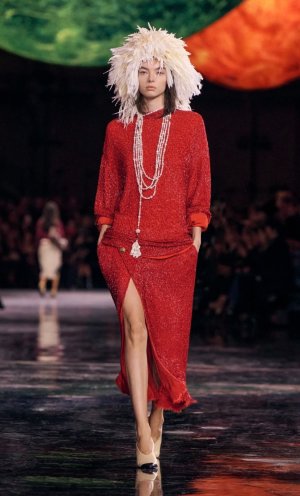
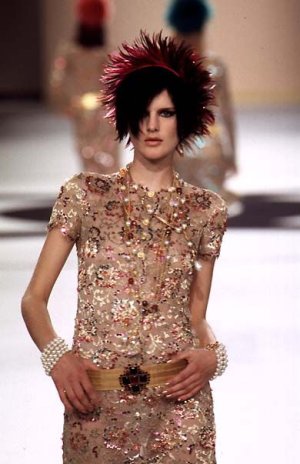
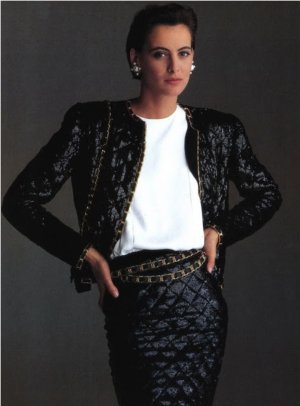
Instead we got coco (chocolate) sprinkles on 25 Flavored ice cream ego mess.
In couture later its ok do more experiment KL did allot of versions of chanel thats where never real chanel also but that fine he was there 36 years Blazy its his first few months and he does this ego trip.
minimal chanel we know it can happen later also upside down chanel all fine .
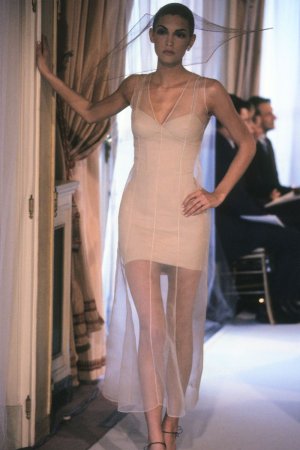
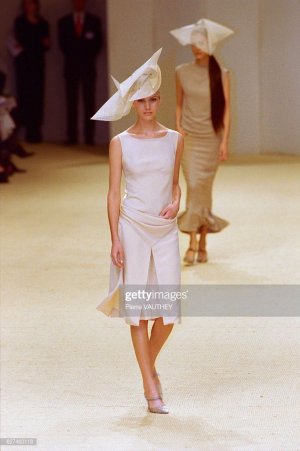
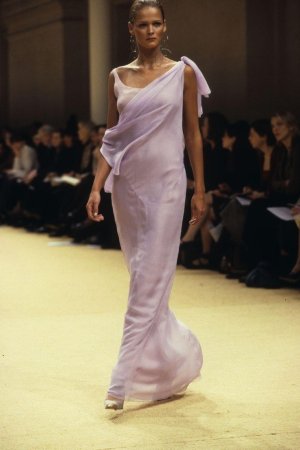
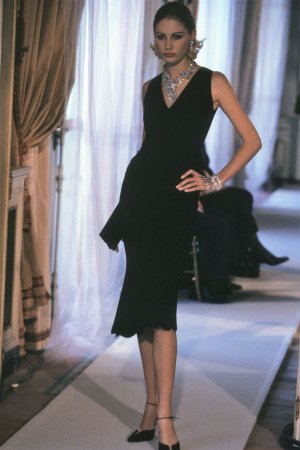
Even 80´s Sari drape Chanel looks better made technically then this 2025 Blazy mess
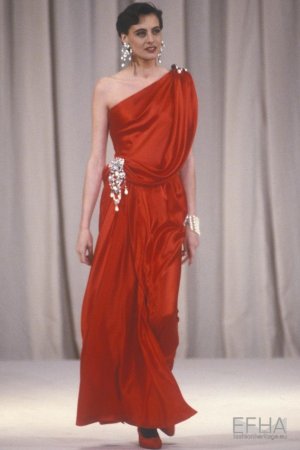
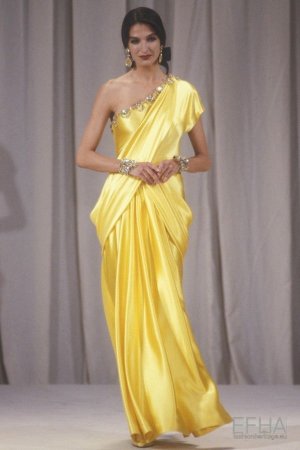
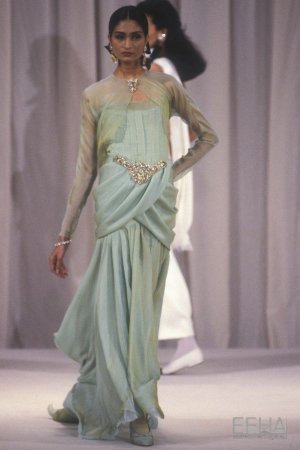
this one for Lola :-)
its ok i don't need promiscuous Chanel 70´s or 90´s i love that its lady but bulky is not Chanel what Blazy does is bulky and it's what i hated when KL or VV did it as well they are old what is his excuse ? ( again not speaking about tight clothes it's about cut and balance and construction and fabric choice or manipulation skills )
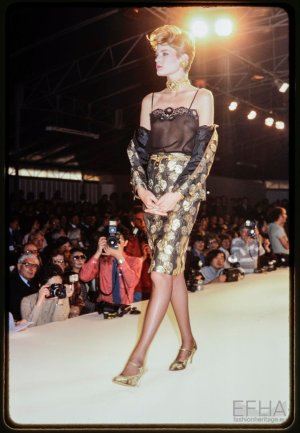
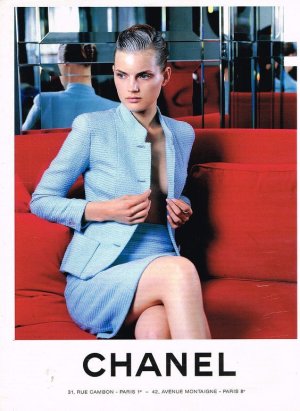
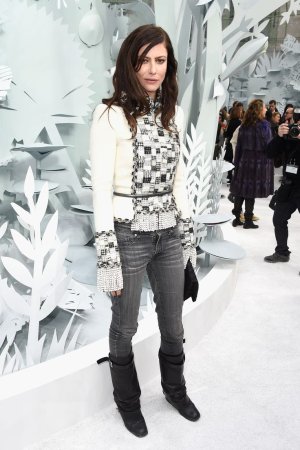
Alquimista
Well-Known Member
- Joined
- Oct 1, 2023
- Messages
- 1,089
- Reaction score
- 3,160
PDFSD
Well-Known Member
- Joined
- Mar 27, 2024
- Messages
- 2,821
- Reaction score
- 10,017
Because her hubby is paying for it and if they are HC clients i think most of their husbands are happy the wife is in paris and leaving them alone they only maye complain about the chanel bill.That's nice but why would a Chanel woman give a flying f*ck about what men think about her clothes?
Her money is way too long for that sh*t.
View attachment 1425537
this is of course different for the hustles and scammers etc that pay for their own chanel :-)
This hustler doesn't want men to think about my clothes 

Because her hubby is paying for it and if they are HC clients i think most of their husbands are happy the wife is in paris and leaving them alone they only maye complain about the chanel bill.
this is of course different for the hustles and scammers etc that pay for their own chanel :-)
PDFSD
Well-Known Member
- Joined
- Mar 27, 2024
- Messages
- 2,821
- Reaction score
- 10,017
yet here we are :-) , most designers are men even if gay are still men the teams are largely also men, sales assistant stylist merchandisers etc so its many filters of gay maffia/ men shades before that dress or shoes is in your shopping bag that you hustled for ...to quote Miranda Presly? i don't know her name lol but you know what i mean.This hustler doesn't want men to think about my clothes
honestly the power dressing thing goes for men and women in corporate setting every one is a victim in the end because its all drag to impress.
Alquimista
Well-Known Member
- Joined
- Oct 1, 2023
- Messages
- 1,089
- Reaction score
- 3,160
Nobody said it isn't visual. I just find your comparisons preposterous.Why yo so mad bro/sis we just looking at frayed dresses with wheat straw pom pom flowers.
It's obvious they saw modernity in Blazy (Phoebe Philo´s) work nobody denies this and its what we all said what we will expect of his new Chanel to be modern.
There is no Mystery with Blazy that we already established.
Mine was lol ....My jaw was on the floor when i went back to see how many ugly stuff he did.
i am sure he overwhelmed chanel ceo´s with thousand of crafty ways to do pompons (can use your word Technique here?) and checks Techniques , and they were so drunk on his work that they decided it must be him.
i dont understand why your not happy to see Blazy have a design language so strong it even overrides coco chanel codes.
lol
You need to understand that even when you transpose a shape or technique to a different context, you need discerniment. Blazy is bringing things he finds fitting for Chanel, like the play with textures, the trompe l'oil illusions where tweed assumes different skins, and different fabrics that are made to look like tweed, the loose shapes, the witty pompons that have the spirit of Karl 's showpieces. Every element is there because he thinks it makes sense for Chanel. You can disagree with that, as I can disagree that Chanel was "overrided" by Blazy elements.
With Chanel, the design process has to be circular. Blazy can go as far away from Gabrielle as he desire, but he always should arrive back at Rue Cambon. That was the deal. And that's how Karl operated , and Karl went to places Gabriele would not step foot.
PDFSD
Well-Known Member
- Joined
- Mar 27, 2024
- Messages
- 2,821
- Reaction score
- 10,017
I said it's visual because you object to pictures to illustrate an common tread. (you keep moving the goalpost of Despise)lolNobody said it isn't visual. I just find your comparisons preposterous.
You need to understand that even when you transpose a shape or technique to a different context, you need discerniment. Blazy is bringing things he finds fitting for Chanel, like the play with textures, the trompe l'oil illusions where tweed assumes different skins, and different fabrics that are made to look like tweed, the loose shapes, the witty pompons that have the spirit of Karl 's showpieces. Every element is there because he thinks it makes sense for Chanel. You can disagree with that, as I can disagree that Chanel was "overrided" by Blazy elements.
With Chanel, the design process has to be circular. Blazy can go as far away from Gabrielle as he desire, but he always should arrive back at Rue Cambon. That was the deal. And that's how Karl operated , and Karl went to places Gabriele would not step foot.
Preposterous or comparison would be BLazy against Moschino by Jeremy scott when he did Chanel, wich is where it actually belongs with Miranda & Co.
I don't need to understand ...i know .....but love what you love, i dislike what i dislike.
use your words to praise his technique to a different context, with all the discernment left on the planet.
I think Blazy arrived somewhere between Piazza San Fedele (HQ of BV) and his new paris address its not Rue Cambon my dear !
Chanel can travel to space and everywhere i said it already it can be even upside down Chanel, but we seen it with first show and first act drop its a Minestrone soup of brands more than Chanel and objectively ugly.
Monsieur Cristobal
Well-Known Member
- Joined
- Oct 27, 2024
- Messages
- 784
- Reaction score
- 3,476
Sorry to interrupt but Inès in Chanel was sublime.i agree i am sure they looks at chanel ism and Bottega-fied (modified) them.
wich in theory is fine if BV is who he is , but again the whole big CEO message was some on that respect or comes to do chanel not repeat what they do at another house.
so my irk is its not enough hardcore chanel what you expect in RTW
BALANCE OF THE EGO should be :
Hard core COCO CHANEL 2/4 - BLAZY SANS BV 1/4 - BLAZY KL CHANEL 1/4
View attachment 1425517View attachment 1425519View attachment 1425530View attachment 1425518
Instead we got coco (chocolate) sprinkles on 25 Flavored ice cream ego mess.
In couture later its ok do more experiment KL did allot of versions of chanel thats where never real chanel also but that fine he was there 36 years Blazy its his first few months and he does this ego trip.
minimal chanel we know it can happen later also upside down chanel all fine .
View attachment 1425520View attachment 1425521
View attachment 1425522View attachment 1425523
Even 80´s Sari drape Chanel looks better made technically then this 2025 Blazy mess
View attachment 1425524View attachment 1425525View attachment 1425526
this one for Lola :-)
its ok i don't need promiscuous Chanel 70´s or 90´s i love that its lady but bulky is not Chanel what Blazy does is bulky and it's what i hated when KL or VV did it as well they are old what is his excuse ? ( again not speaking about tight clothes it's about cut and balance and construction and fabric choice or manipulation skills )
View attachment 1425527View attachment 1425528View attachment 1425529
PDFSD
Well-Known Member
- Joined
- Mar 27, 2024
- Messages
- 2,821
- Reaction score
- 10,017
Creative
Well-Known Member
- Joined
- Oct 1, 2007
- Messages
- 5,763
- Reaction score
- 5,720
Fashion forward? Where? 😅Yes, it’s a very fashion-forward proposition - and no, it’s not masculine-presenting at all. That’s exactly my point. Its not mens clothes translated to womens clothes.
The new generation of women can wear fragile Chanel suits covered in puffy flowers and still be taken completely seriously. We’ve moved past power dressing. We’re beyond the idea that equality means wearing a man’s suit. Now it’s knit suits with plaid sequin fringe in the boardroom - and why not? What’s new about power dressing in 2025?
This is what I mean by postmodern.
Blazy is clearly influenced by Galliano, many of these silhouettes trace back to the draping techniques John pioneered. The treatment of the waist and hips especially - the way the blousing is done across the lower bust and lower thighs - it’s very Galliano 1920s filtered through Chanel. I completely see why they chose him and Im excited to see more dramatic flapper inspired draping.
This feels right for Chanel because it retains their fashion credentials plus moves the dressing conversation back to the Chanel suit leading style.
PDFSD
Well-Known Member
- Joined
- Mar 27, 2024
- Messages
- 2,821
- Reaction score
- 10,017
Fashion forward? Where? 😅
in SPRING 2014 🤭 😂 
i think he is stuck in this moment:
art gallery lady jaring colors and abstract prints layers over skirts, mid waste overall oddness in proportions , chokers funky of shoulders oversized coats the style of shoes he keeps using is form this collection as well same square toes low mid heel, tartan woven , fraying crafty look , leather fringe poms poms its all in this one collection of Phoebe etc etc
all part of the Blazy starter pack :
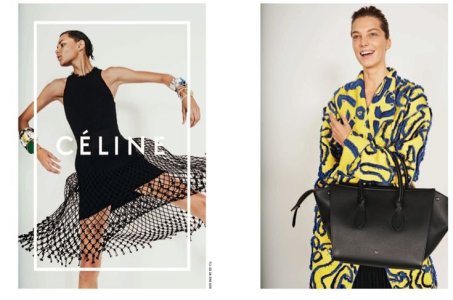
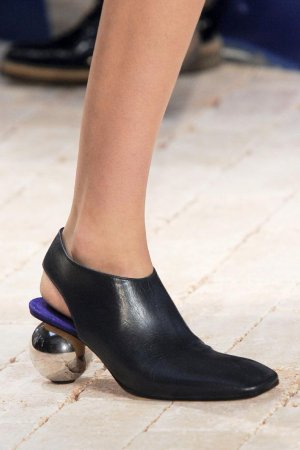
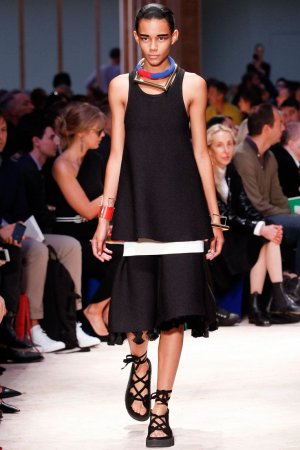
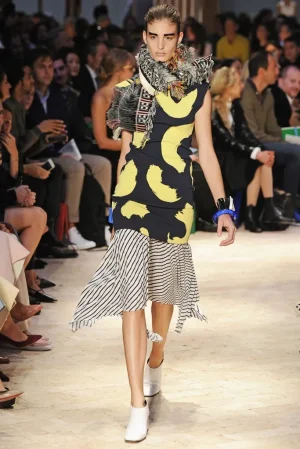
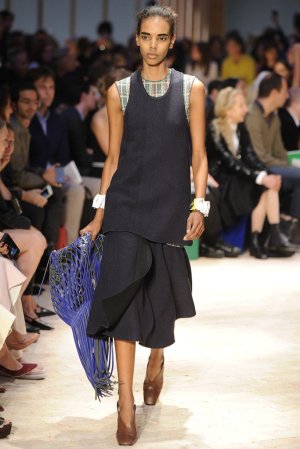
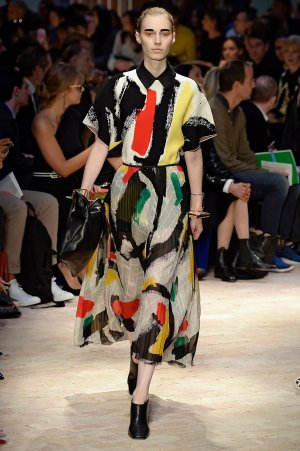
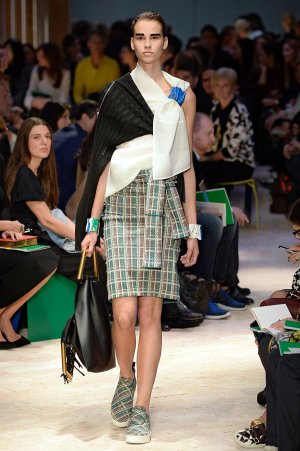
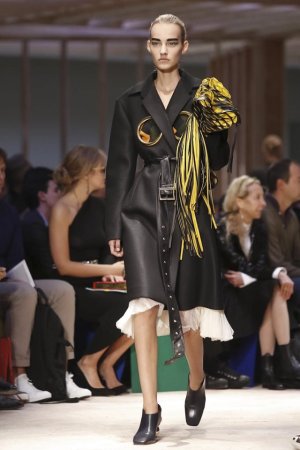
KilltheLook
Well-Known Member
- Joined
- Jul 19, 2008
- Messages
- 118
- Reaction score
- 446
That collection also marked the turning point of Phoebe's Celine - less sharp silhouettes and more "everything and the sink" styling tricks. Wish Mathieu have taken Celine Spring 2010 as the jumping point though for his Chanel. That would have been so much more chic and modern.in SPRING 2014 🤭 😂
i think he is stuck in this moment:
art gallery lady jaring colors and abstract prints layers over skirts, mid waste overall oddness in proportions , chokers funky of shoulders oversized coats the style of shoes he keeps using is form this collection as well same square toes low mid heel, tartan woven , fraying crafty look , leather fringe poms poms its all in this one collection of Phoebe etc etc
all part of the Blazy starter pack :
View attachment 1425550
View attachment 1425551View attachment 1425552View attachment 1425553View attachment 1425554View attachment 1425555View attachment 1425556View attachment 1425557
psychopsist
Active Member
- Joined
- Feb 18, 2025
- Messages
- 64
- Reaction score
- 212
I somewhat agree
I somewhat agree. His stated agenda was to “do a show like it was [his] last.” And for better or for worse it does feel that way…the pom poms, the hats, the oversized shirts, ball skirts, the camellias, the finale twirl, all on the space backdrop… the show easily could’ve been nicknamed “the starburst.”
For me, the unfortunate part is a lot of the obviously Chanel looks, like many of the skirt suits, jackets and tweed, go too hard into the bulk and the hay fever… like 15ish looks I just honestly have a hard time imagining anyone feel inspired to purchase or emulate the more I look. The frayed tans and yellows, the patterns involving mint green and dusty creams on grey or primary combos… they don’t help. It feels very abandoned scarecrow, sushi roll wrapping paper, porcupine with some chronic illness, grandparents’ ugly Easter decorations. I understand the symbolism but it’s just too much grass not enough sass. And it’s kind of a lot on the eyes.
I think Spring 2004 both RTW & Couture used color better, including many of the same ones. Part of it is the shows were each only around 60 looks instead of 80, and both had a lot of just black and white looks. But the pink, tan, cream etc looks were monochrome and the patterns contained complimentary hues.
Looks 52(draping gown later worn by Ayo), and 67(that three tiered scarlet flamecoish skirt) stand out for their visual purity, harmony and ease. I think that’s why those are my favorites. The crochet/bouclé suits also work for me.
i agree i am sure they looks at chanel ism and Bottega-fied (modified) them.
wich in theory is fine if BV is who he is , but again the whole big CEO message was some on that respect or comes to do chanel not repeat what they do at another house.
so my irk is its not enough hardcore chanel what you expect in RTW
BALANCE OF THE EGO should be :
Hard core COCO CHANEL 2/4 - BLAZY SANS BV 1/4 - BLAZY KL CHANEL 1/4
its ok i don't need promiscuous Chanel 70´s or 90´s i love that its lady but bulky is not Chanel what Blazy does is bulky and it's what i hated when KL or VV did it as well they are old what is his excuse ? ( again not speaking about tight clothes it's about cut and balance and construction and fabric choice or manipulation skills )
I somewhat agree. His stated agenda was to “do a show like it was [his] last.” And for better or for worse it does feel that way…the pom poms, the hats, the oversized shirts, ball skirts, the camellias, the finale twirl, all on the space backdrop… the show easily could’ve been nicknamed “the starburst.”
For me, the unfortunate part is a lot of the obviously Chanel looks, like many of the skirt suits, jackets and tweed, go too hard into the bulk and the hay fever… like 15ish looks I just honestly have a hard time imagining anyone feel inspired to purchase or emulate the more I look. The frayed tans and yellows, the patterns involving mint green and dusty creams on grey or primary combos… they don’t help. It feels very abandoned scarecrow, sushi roll wrapping paper, porcupine with some chronic illness, grandparents’ ugly Easter decorations. I understand the symbolism but it’s just too much grass not enough sass. And it’s kind of a lot on the eyes.
I think Spring 2004 both RTW & Couture used color better, including many of the same ones. Part of it is the shows were each only around 60 looks instead of 80, and both had a lot of just black and white looks. But the pink, tan, cream etc looks were monochrome and the patterns contained complimentary hues.
Looks 52(draping gown later worn by Ayo), and 67(that three tiered scarlet flamecoish skirt) stand out for their visual purity, harmony and ease. I think that’s why those are my favorites. The crochet/bouclé suits also work for me.
yslforever
Well-Known Member
- Joined
- Nov 13, 2021
- Messages
- 2,323
- Reaction score
- 8,098
Yves told me once that women go to Chanel once they have checked out of their marriage… 😂Because her hubby is paying for it and if they are HC clients i think most of their husbands are happy the wife is in paris and leaving them alone they only maye complain about the chanel bill.
this is of course different for the hustles and scammers etc that pay for their own chanel :-)
PDFSD
Well-Known Member
- Joined
- Mar 27, 2024
- Messages
- 2,821
- Reaction score
- 10,017
that's exactly the look no joke he was right.Yves told me once that women go to Chanel once they have checked out of their marriage… 😂
PDFSD
Well-Known Member
- Joined
- Mar 27, 2024
- Messages
- 2,821
- Reaction score
- 10,017
yes he said he felt to have to ways to do it ......clearly he chose the easy self indulging one his Lazyism´sI somewhat agree
I somewhat agree. His stated agenda was to “do a show like it was [his] last.” And for better or for worse it does feel that way…the pom poms, the hats, the oversized shirts, ball skirts, the camellias, the finale twirl, all on the space backdrop… the show easily could’ve been nicknamed “the starburst.”
For me, the unfortunate part is a lot of the obviously Chanel looks, like many of the skirt suits, jackets and tweed, go too hard into the bulk and the hay fever… like 15ish looks I just honestly have a hard time imagining anyone feel inspired to purchase or emulate the more I look. The frayed tans and yellows, the patterns involving mint green and dusty creams on grey or primary combos… they don’t help. It feels very abandoned scarecrow, sushi roll wrapping paper, porcupine with some chronic illness, grandparents’ ugly Easter decorations. I understand the symbolism but it’s just too much grass not enough sass. And it’s kind of a lot on the eyes.
I think Spring 2004 both RTW & Couture used color better, including many of the same ones. Part of it is the shows were each only around 60 looks instead of 80, and both had a lot of just black and white looks. But the pink, tan, cream etc looks were monochrome and the patterns contained complimentary hues.
Looks 52(draping gown later worn by Ayo), and 67(that three tiered scarlet flamecoish skirt) stand out for their visual purity, harmony and ease. I think that’s why those are my favorites. The crochet/bouclé suits also work for me.
because as he said himself he is not able to edit and why choose bla bla in interviews
The Vogue interview piece i just put myself to read today on his Chanel work approach:
He will often say he has made a collection before a single garment is designed. What he means is that he and his research chief, Marie-Valentine Girbal, have—arduously, carefully—collected dozens of mood board images and swatches in binders, labelled as specific looks. From there, the binders go on to his design deputies who, with free rein, mock up pieces inspired by what they see; then Blazy and the deputies spend weeks working over these propositions, nixing some, refining details on others
*And this is why the out come is so messy !!!!
The hard work would have been to dissect and reconstruct Chanel in steps that carefully re establishes the codes in a fresh modern way now you have show and the act 1 look just like random stuff that next season mean nothing.
Also stuff like this from the vogue interview that don't add up to the results :
The first time Blazy was asked what his vision of Chanel was, the answer came to him swiftly:
“I said, ‘Chanel is modern.’”
(He traveled to Normandy to visit Alain Wertheimer, the company chair. “We almost didn’t speak about Chanel,” Blazy says. “He told me, ‘If you’re in front of me, it means you’re supposed to be a good designer, so let’s not talk about work.’” They conferred instead about childhood, about family, about their shared interests in art. During the last five minutes of the interview, Wertheimer circled back to fashion, and that was when Blazy made his remark about modernity.)
“He asked me, ‘Do you think Chanel is modern now?’ I said, ‘I think the pillars are still modern, but we can push it.’” On which Wertheimer smiled.
Bruno Pavlovsky, the president of fashion at Chanel, tells me that he and his colleagues had a very clear idea of the designer they were looking for: a genius who could inhabit the brand. “With some designers, it’s about their vision, even as they go from one brand to another,” he says. “What we have learned to like at Chanel is a chameleon”: someone who would use their imaginative brilliance to revivify the house on its own terms. “Matthieu has a vision—we love him as Matthieu—but he puts everything behind the brand.”
Blazy says he is pleased with the summer’s work; his studio has begun to come up with good ideas. “Everyone tells me, ‘I’m so excited about your show.’ But I’m so excited too—I don’t know quite what it is exactly yet.
*Clear to me he started the project as always randomly go with the flow.
Start with a coat. A men’s sport coat—British, say—in tweed: the everyday archetype of refined masculinity. Put it on a woman. Take a pair of shears to the bottom; cut it at the hip. Close the lapels. Add a button or two. “Suddenly you have the archetype of a Chanel jacket—from a man’s,”
It was an exercise in stripping away a century of thickly layered development at the house, returning to the original shock of the new.
.....he would return to the creative path of Gabrielle “Coco” Chanel and take a different turn. The men’s-jacket exercise announced that change
*LOL
“When you go back to the early years of Gabrielle Chanel, a lot of things happened that haven’t been told yet, even though they resulted in codes.”
*what are those in the first show ? shapeless sack dresses ? what are his codes for chanel ?
Charvet
“They knew things I didn’t know—that, for example, Coco would buy gifts for her boyfriend in that store,” he says.
Her masculine borrowing has been remarked upon, but Blazy understood it as a reach for freedom of a specific kind.
In the early 1910s, Coco attended a fancy-dress party in men’s clothes. Unlike most of the other guests, she put on the same outfit the next morning, bringing it into the realm of the everyday.
“She didn’t want to look like a woman that men bought everything for. She liked to ride horses. She was always on the go,” he says. And her clothes were conceived by pragmatic circumstance. (Where is that in Blazy version ?)
“What you quickly find out is that Chanel could not exist, in the aesthetic we all know, if she was not in love with that man,” Blazy says. ( Also rewriting history is part of his job description we just don't know if this would been the case )
And understanding Coco as someone who designed by circumstance opened new realms for development.
*chaos what Blazy likes its clear.
During the interregnum last year, one heard it posited that only a designer rooted in French life could catch the mood of so quintessentially Parisian a house. Blazy, a Parisian born and bred, recoiled from the claim. (“I disagree! I’m half Belgian!” he exclaims.)
*That's why i said he is like Pieter and Raf they have all 3 very belgium taste approach to design overthinking and child naicty to disguise lack of emotional intelligence in the work. what a Alaia or Hedi do have even when teh both ahve a love for sharpnes and tailoring .
Chanel lightness that I really want to explore,” he says. “Couture doesn’t need to be heavy. It doesn’t need to be big. It’s something about the making, how it falls on the body.” In the Belgian style, he likes to work in the round, with scissors in hand.
*he needs glasses because the bulk i his clothes are not lightness and RTW skirts did not need to be so big not just couture.
“It’s going to go quite in a lot of directions. I need to test ideas. I want to make mistakes. It doesn’t have to be perfect—it’s a first show. It’s a proposal.”
*Its clear but i doubt it will get clearer looking back at 3 year of BV i see no refment of vision just endless experiments and complications in design for no reason than consumed ego trip
Similar Threads
- Replies
- 1K
- Views
- 173K
- Replies
- 64
- Views
- 15K
- Replies
- 2
- Views
- 3K
- Replies
- 11
- Views
- 6K
- Replies
- 266
- Views
- 43K
Users who are viewing this thread
Total: 4 (members: 0, guests: 4)
New Posts
-
US Harper's Bazaar Winter 2025 : Meghan, Duchess of Sussex by Malick Bodian (14 Viewers)
- Latest: tomtakesphotos
-
-
-
-


